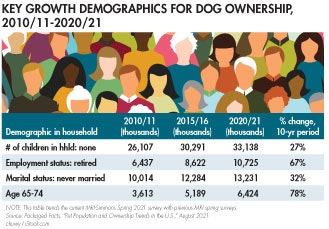
Over the previous decade, some of the key growth for dog ownership has primarily been in demographics traditionally under-represented as dog owners. This trend is spurred by several dynamics, including the graying of the U.S. population and the shifting composition of American households, but also reflects the deepening appeal of dog ownership to a widening range of demographics.
Dog ownership growth by demographic
MRI-Simmons National Consumer Study data show, for example, that while the number of households without children at home grew by 20% between 2010-11 and 2020-21, the number of dog-owning households without children grew by 27%, or by 7.0 million to 33.1 million (see Table 1). “Pets as family” is a driver here, and a consumer mindset that motivates higher spending on pet products and services, including pet food.

TABLE 1: Older demographics in particular have seen an interesting and significant rise in dog ownership over the last decade.
Similarly, while the number of retiree households grew by 35% over the last decade, the number of dog-owning retiree households grew by 67%. A specter that previously shadowed pet industry projections — that pet ownership rates would drop as Boomers aged out of the traditional households-with-children and dog-owning years — has been vanquished by increased enthusiasm for dog ownership at both ends of the adult age spectrum. Therefore, while the number of households with 65- to 74-year-olds grew by 60% over the last decade, as Boomers grayed into this bracket, the number of dog-owning households in this age cohort grew by 78%.
Another indication that married households with children at home aren’t the go-to demographic in dog ownership growth is that while the number of households with never-married adults grew by 22% over the last decade, the number of dog-owning households with never-married adults grew by 32%.
The “multiple pet” trend in the COVID-19 era
A “multiple-pet” trend—owning multiple pets of a single type and owning multiple types of pets—has become one of the pet industry megatrends in this stay-at-home-more/work-from-home-more COVID-19 era, and the key growth demographics for owning two or more dogs generally follow the growth patterns in dog-owning households overall:
- While the number of households without children at home grew by 20% over the last decade, and the number of dog-owning households without children grew by 27%, the number of 2+ dog households without children grew by 29%.
- While the number of retiree households grew by 35% between over the last decade, and the number of dog-owning retiree households grew by 67%, the number of 2+ dog-owning retiree households grew by 88%.
Not only have these patterns — accelerated by COVID-19 pandemic impacts—fueled pet population growth, but they will continue to do so into the future. The Census Bureau, for example, projects the number of Americans ages 65-74 to grow by 18% between 2020 and 2030. So while recent pet population growth trends have been unprecedented, they also portend dog population growth extending into the future.
Editor’s note: Next month’s column will cover parallel trends in cat-owning demographics.

















